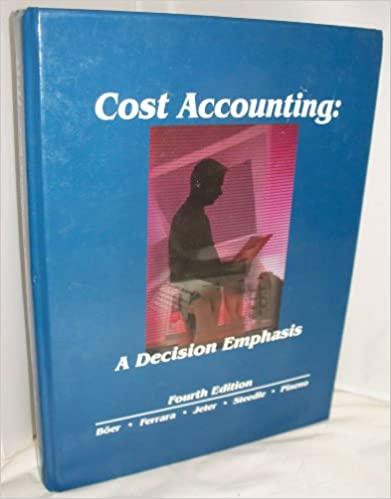Concepts: Variable cost Fixed cost Totalcost Total revenue Average revenue Marginal revenue Demand Curve Average total cost Marginal cost Mark Sampson, President of Sampson Switch Company must consider the pricing and production for the Ultra Switch Model B, one o the company's top selling models. Switch production includes grinding and assembly of finished components. Marketing efforts consist primarily of print ads in trade publications. Last year the Model B produced a profit of $8,000 Production facts. Sampson hires part time workers on an "as needed" basis to do the grinding task. On average, a grinder is paid $8.00 per hour and s/he is expected to produce 200 switch plates per each 8-hour day. Switch assemblers, also part-time workers, are paid S50 per day and they are expected to assemble 5 switches per hour. Each switch consists of two switch plates and assorted other components (the cost of the "other components" is S3.11 per switch). Fixed Costs. Other costs include the year-long contract for the rental of the assembly line equipment (S1,000 per month). Marketing facts According to next year's plan, Mark expects to place 10 black and white print ads (each S500) and two special feature, color ads (each $2,500) for the Model B. Salaries for the marketing sales force that are allocated to the Model B will total $18,000 next year. la. What is the cost to produce one switch? (ie, the unit variable cost)? lb. What and how much are the items composing the total "fixed" costs for next year? Ic. Graph the relationship between quantity produced (on the X-axis) and Total Cost (on the Y-axis). ld. How much is the per-unit contribution if the product is priced at $15 a unit? le. What was the profit last year? What will be the change in profitability for the Model B if the product is priced at $15 per unit and 2,500 units are sold? If. What is the breakeven point if the product is priced at S15? How many must be sold next year in order to produce the same profit level as last year? g. Assume that Mark has S50,000 in equity invested in the Model B line. How many units must be sold in order to return 25% on his equity? 2. Answer qs la-g assuming that the selling price is reduced to S10 and demand increases by a factor of four 3. After much investigation, the marketing research department tells Mark that they expect the "demand curve"to be. Compare the expected demand with the breakeven point for each price point. Knowing this information, what price should Mark charge in order to maximize profits on the Model B? Units demanded Selling price S15 S10 S9 S8 S7 Breakeven Point 10,000 13,000 14,000 15,000 4a- Create a graph showing "Quantity Demanded" on the X-axis and "Total Revenue S" on the Y-axis for each of the five price-quantity demanded points listed in q 3 above. 4b. Create a graph that superimposes the Total Revenue for the five points of the "Demand Curve" on the "Breakeven" Chart of the Model B (note the SS Y -axis will represent Total Revenue for the Demand curve and will represent Total Cost for the Breakeven chart). 01.81 gif k&b785 g pees]







